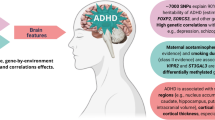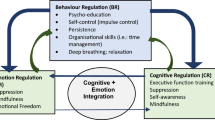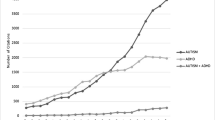Abstract
Objectives
A few clinical observations reported that children with attention deficit hyperactivity disorder (ADHD) have poor oral health compared to children without ADHD. However, evidence is not conclusive. We assess the association between hyperactivity/inattention and oral health in a population-based study.
Material and methods
As part of the ongoing birth cohort studies German Infant Nutritional Intervention-plus (GINIplus) and Influences of lifestyle-related factors on the immune system and the development of allergies in childhood-plus (LISAplus), 1,126 children at age 10 years (±10.2) from Munich (Germany) were included in the present analysis. During the dental examination, oral hygiene, non-cavitated and cavitated caries lesions, dental trauma, and enamel hypomineralization (EH) in the permanent dentition (MIH/1) were recorded. Children with a Molar-Incisor-Hypomineralization were subcategorized into those with EH on at least one first permanent molar (MIH/1A), and on at least one first permanent molar and permanent incisor (MIH/1B). Data on children’s hyperactivity/inattention symptoms were collected by parent-reported Strength and Difficulties Questionnaire. Logistic regressions and zero-inflated Poisson regression models were applied adjusted for gender, parental education, parental income, and methylphenidate or atomoxetine medication.
Results
Logistic regressions showed that non-cavitated caries lesions were positively related with the presence of hyperactivity/inattention (ORadj = 1.51,CI95% = 1.08–2.11). When adjusted for parental background, an association showed between hyperactivity/inattention symptoms and MIH/1A but did not reach statistical significance (ORadj = 1.59,CI95% = 1.00–2.53).
Conclusions
Children with borderline and abnormal values of hyperactivity/inattention symptoms showed more non-cavitated caries lesions. Severe levels of hyperactivity/inattention may contribute to a higher risk for MIH/1A in school age.
Clinical relevance
Adequate dental preventive care for children with hyperactivity/inattention, especially from a low social background, is of importance for optimal caries prevention.
Similar content being viewed by others
References
Marthaler TM (2004) Changes in dental caries 1953–2003. Caries Res 38(3):173–181. doi:10.1159/000077752
Schiffner U, Hoffmann T, Kerschbaum T, Micheelis W (2009) Oral health in German children, adolescents, adults and senior citizens in 2005. Community Dent Health 26(1):18–22
Geyer S, Schneller T, Micheelis W (2010) Social gradients and cumulative effects of income and education on dental health in the Fourth German Oral Health Study. Community Dent Oral Epidemiol 38(2):120–128. doi:10.1111/j.1600-0528.2009.00520.x
Kühnisch J, Heinrich-Weltzien R, Senkel H, Clasen A, Stößer L (2001) Dental health and caries topography in 8-year-old German and immigrant children. Eur J Paediatr Dent 2:191–196
Bagramian RA, Garcia-Godoy F, Volpe AR (2009) The global increase in dental caries. A pending public health crisis. Am J Dent 22(1):3–8
Mach DS (2009) Zahngesundheit unter besonderer Berücksichtigung von (Molaren-Inzisiven-)Hypomineralisationen bei 10-Jährigen in München. Doctoral Thesis, Ludwig-Maximilians-University of Munich, Munich
Jalevik B (2010) Prevalence and diagnosis of Molar-Incisor-Hypomineralisation (MIH): a systematic review. Eur Arch Paediatr Dent 11(2):59–64
Lygidakis NA, Wong F, Jalevik B, Vierrou AM, Alaluusua S, Espelid I (2010) Best clinical practice guidance for clinicians dealing with children presenting with Molar-Incisor-Hypomineralisation (MIH): an EAPD policy document. Eur Arch Paediatr Dent 11(2):75–81
Weerheijm KL, Duggal M, Mejare I, Papagiannoulis L, Koch G, Martens LC, Hallonsten AL (2003) Judgement criteria for molar incisor hypomineralisation (MIH) in epidemiologic studies: a summary of the European meeting on MIH held in Athens, 2003. Eur J Paediatr Dent 4(3):110–113
Weerheijm KL, Jalevik B, Alaluusua S (2001) Molar-incisor hypomineralisation. Caries Res 35(5):390–391
Jalevik B, Klingberg GA (2002) Dental treatment, dental fear and behaviour management problems in children with severe enamel hypomineralization of their permanent first molars. Int J Paediatr Dent 12(1):24–32
Grooms MT, Keels MA, Roberts MW, McIver FT (2005) Caries experience associated with attention-deficit/hyperactivity disorder. J Clin Pediatr Dent 30(1):3–7
Chandra P, Anandakrishna L, Ray P (2009) Caries experience and oral hygiene status of children suffering from attention deficit hyperactivity disorder. J Clin Pediatr Dent 34(1):25–29
Wolraich M (1998) Attention deficit hyperactivity disorder. Prof Care Mother Child 8(2):35–37
Friedlander AH, Yagiela JA, Mahler ME, Rubin R (2007) The pathophysiology, medical management and dental implications of adult attention-deficit/hyperactivity disorder. J Am Dent Assoc 138(4):475–482, quiz 535, 537
Broadbent JM, Ayers KM, Thomson WM (2004) Is attention-deficit hyperactivity disorder a risk factor for dental caries? a case–control study. Caries Res 38(1):29–33. doi:10.1159/000073917
Blomqvist M, Holmberg K, Fernell E, Ek U, Dahllof G (2006) Oral health, dental anxiety, and behavior management problems in children with attention deficit hyperactivity disorder. Eur J Oral Sci 114(5):385–390. doi:10.1111/j.1600-0722.2006.00393.x
Bimstein E, Wilson J, Guelmann M, Primosch R (2008) Oral characteristics of children with attention-deficit hyperactivity disorder. Spec Care Dent 28(3):107–110. doi:10.1111/j.1754-4505.2008.00021.x
Alaluusua S (2010) Aetiology of Molar-Incisor Hypomineralisation: a systematic review. Eur Arch Paediatr Dent 11(2):53–58
Filipiak B, Zutavern A, Koletzko S, von Berg A, Brockow I, Grubl A, Berdel D, Reinhardt D, Bauer CP, Wichmann HE, Heinrich J (2007) Solid food introduction in relation to eczema: results from a four-year prospective birth cohort study. J Pediatr 151(4):352–358. doi:10.1016/j.jpeds.2007.05.018
von Berg A, Koletzko S, Filipiak-Pittroff B, Laubereau B, Grubl A, Wichmann HE, Bauer CP, Reinhardt D, Berdel D (2007) Certain hydrolyzed formulas reduce the incidence of atopic dermatitis but not that of asthma: three-year results of the German Infant Nutritional Intervention Study. J Allergy Clin Immunol 119(3):718–725. doi:10.1016/j.jaci.2006.11.017
Schnabel E, Sausenthaler S, Schaaf B, Schafer T, Lehmann I, Behrendt H, Herbarth O, Borte M, Kramer U, von Berg A, Wichmann HE, Heinrich J (2010) Prospective association between food sensitization and food allergy: results of the LISA birth cohort study. Clin Exp Allergy 40(3):450–457. doi:10.1111/j.1365-2222.2009.03400.x
Heinrich J, Bolte G, Holscher B, Douwes J, Lehmann I, Fahlbusch B, Bischof W, Weiss M, Borte M, Wichmann HE (2002) Allergens and endotoxin on mothers’ mattresses and total immunoglobulin E in cord blood of neonates. Eur Respir J 20(3):617–623
Goodman R (1997) The strengths and difficulties questionnaire: a research note. J Child Psychol Psychiatry 38(5):581–586
Woerner W, Becker A, Rothenberger A (2004) Normative data and scale properties of the German parent SDQ. Eur Child Adolesc Psychiatry 13(Suppl 2):II3–II10. doi:10.1007/s00787-004-2002-6
Muhlemann HR, Son S (1971) Gingival sulcus bleeding—a leading symptom in initial gingivitis. Helv Odontol Acta 15(2):107–113
Loe H, Silness J (1963) Periodontal disease in pregnancy. I. Prevalence and severity. Acta Odontol Scand 21:533–551
Kuhnisch J, Goddon I, Berger S, Senkel H, Bucher K, Oehme T, Hickel R, Heinrich-Weltzien R (2009) Development, methodology and potential of the new Universal Visual Scoring System (UniViSS) for caries detection and diagnosis. Int J Environ Res Public Health 6(9):2500–2509. doi:10.3390/ijerph6092500
Kuhnisch J, Bucher K, Henschel V, Albrecht A, Garcia-Godoy F, Mansmann U, Hickel R, Heinrich-Weltzien R (2011) Diagnostic performance of the universal visual scoring system (UniViSS) on occlusal surfaces. Clin Oral Investig 15(2):215–223. doi:10.1007/s00784-010-0390-1
Heitmuller D, Thiering E, Hoffmann U, Heinrich J, Manton D, Kuhnisch J, Neumann C, Bauer CP, Heinrich-Weltzien R, Hickel R (2012) Is there a positive relationship between molar incisor hypomineralisations and the presence of dental caries? Int J Paediatr Dent. doi:10.1111/j.1365-263X.2012.01233.x
Atkins DC, Gallop RJ (2007) Rethinking how family researchers model infrequent outcomes: a tutorial on count regression and zero-inflated models. J Fam Psychol 21(4):726–735. doi:10.1037/0893-3200.21.4.726
Boehning D, Dietz E, Schlattmann P (1997) Zero-inflated count models and their applications in public health and social science. In: Rost J, Langeheine R (eds) Applications of latent trait and latent class models in the social sciences. Wachsmann, Muenster, pp 333–344
Liu W, Cela J (2008) Count data models in SAS. Statistics and Data Analysis: 1–12
Ahrens W, Bellach BM, Joeckel KH (1998) Messung soziodemographischer Merkmale in der Epidemiologie. Schriften wissenschaftlicher Institute. RKI Schriften. Urban & Vogel
Hauser R (1988) Adequacy and poverty among the retired. AGEING WORKING PAPERS AWP 3.2, vol OECD-Organisation for Economic Co-operation and Development, Paris
Stiegler P, Sausenthaler S, Buyken AE, Rzehak P, Czech D, Linseisen J, Kroke A, Gedrich K, Robertson C, Heinrich J (2010) A new FFQ designed to measure the intake of fatty acids and antioxidants in children. Public Health Nutr 13(1):38–46. doi:10.1017/s1368980009005813
Wiles NJ, Northstone K, Emmett P, Lewis G (2009) ‘Junk food’ diet and childhood behavioural problems: results from the ALSPAC cohort. Eur J Clin Nutr 63(4):491–498. doi:10.1038/sj.ejcn.1602967
Schnoll R, Burshteyn D, Cea-Aravena J (2003) Nutrition in the treatment of attention-deficit hyperactivity disorder: a neglected but important aspect. Appl Psychophysiol Biofeedback 28(1):63–75. doi:10.1023/a:1022321017467
Kohlboeck G, Sausenthaler S, Standl M, Koletzko S, Bauer CP, von Berg A, Berdel D, Kramer U, Schaaf B, Lehmann I, Herbarth O, Heinrich J (2012) Food intake, diet quality and behavioral problems in children: results from the GINI-plus/LISA-plus studies. Ann Nutr Metab 60(4):247–256. doi:10.1159/000337552
US-Department-of-Health-and-Human-Services (2000) Oral health in America: a report of the surgeon general—executive summary
Centers-for-Disease-Control-and-Prevention (2005) Surveillance for dental caries, dental sealants, tooth retention, edentulism, and enamel fluorosis—United States, 1988–1994 and 1999–2002. Morb Mortal Wkly Rep (MMWR) 54(03):1–44
Petersen PE, Lennon MA (2004) Effective use of fluorides for the prevention of dental caries in the 21st century: the WHO approach. Community Dent Oral Epidemiol 32(5):319–321. doi:10.1111/j.1600-0528.2004.00175.x
Hobdell MH, Oliveira ER, Bautista R, Myburgh NG, Lalloo R, Narendran S, Johnson NW (2003) Oral diseases and socioeconomic status (SES). Br Dent J 194(2):91–96
Goodman R, Ford T, Simmons H, Gatward R, Meltzer H (2000) Using the Strengths and Difficulties Questionnaire (SDQ) to screen for child psychiatric disorders in a community sample. Br J Psychiatry 177(6):534–539. doi:10.1192/bjp. 177.6.534
Goodman R, Scott S (1999) Comparing the strengths and difficulties questionnaire and the child behavior checklist: is small beautiful? J Abnorm Child Psychol 27(1):17–24
Achenbach TM, Becker A, Dopfner M, Heiervang E, Roessner V, Steinhausen HC, Rothenberger A (2008) Multicultural assessment of child and adolescent psychopathology with ASEBA and SDQ instruments: research findings, applications, and future directions. J Child Psychol Psychiatry 49(3):251–275. doi:10.1111/j.1469-7610.2007.01867.x
Acknowledgments
We thank all the families who participated in the GINIplus and LISAplus study. Furthermore, we thank all members of the GINIplus and LISAplus study group (see Appendix S1) for their excellent work. The GINIplus and LISAplus were funded by grants 01 EG 9732 and 01 EG 9705/2 from the Federal Ministry for Education, Science, Research, and Technology; 01 EE 9401-4 from the Federal Ministry for Education, Science, Research, and Technology; and FKZ 20462296 from the Federal Ministry of Environment, and Ludwig Maximilians Universities’ innovative research priority Project MC-Health. The dental investigation was funded by a grant of the German Research Foundation (Deutsche Forschungsgemeinschaft, FKZ KU 2518/1-1 and HE 3294/7-1). The GABA GmbH, Lörrach, Germany, supported the dental examination with oral health care packages for all participating children.
Conflict of interest
The authors declare that they have no conflict of interest.
Author information
Authors and Affiliations
Consortia
Corresponding author
Additional information
The GINIplus Study Group comprises the Helmholtz Zentrum München, German Research Center for Environmental Health, Institute of Epidemiology, Munich (Heinrich J, Wichmann HE, Sausenthaler S, Zutavern A, Chen, Chih-Mei, Schnappinger M, and Rzehak P); Department of Pediatrics, Marien-Hospital, Wesel (Berdel D, von Berg A, Beckmann C, Groß I); Department of Pediatrics, Ludwig Maximilians University, Munich (Koletzko S, Reinhardt D, and Krauss-Etschmann S); Department of Pediatrics, Technical University, Munich (Bauer CP, Brockow I, Grübl A, and Hoffmann U); IUF–Institut für Umweltmedizinische Forschung at the Heinrich-Heine-University, Düsseldorf (Krämer U, Link E, and Cramer C); Centre for Allergy and Environment, Technical University, Munich (Behrendt H)
The LISAplus Study Group consists of the following: Helmholtz Zentrum München, German Research Center for Environmental Health, Institute of Epidemiology, Munich (Heinrich J, Wichmann HE, Sausenthaler S, Chen CM, and Schnappinger M); Department of Pediatrics, Municipal Hospital “St.Georg”, Leipzig (Borte M and Diez U), Marien-Hospital Wesel, Department of Pediatrics, Wesel (von Berg A, Beckmann C, and Groß I); Pediatric Practice, Bad Honnef (Schaaf B); Helmholtz Centre for Environmental Research–UFZ, Department of Environmental Immunology/Core Facility Studies, Leipzig (Lehmann I, Bauer M, Gräbsch C, Röder S, and Schilde M); University of Leipzig, Institute of Hygiene and Environmental Medicine, Leipzig (Herbarth O, Dick C, and Magnus J); IUF–Institut für Umweltmedizinische Forschung, Düsseldorf (Krämer U, Link E, and Cramer C); Technical University Munich, Department of Pediatrics, Munich (Bauer CP and Hoffmann U); ZAUM–Center for Allergy and Environment, Technical University, Munich (Behrendt H, Grosch J, and Martin F)
Electronic Supplementary Material
Below is the link to the electronic supplementary material.
ESM 1
(DOC 23 kb)
Rights and permissions
About this article
Cite this article
Kohlboeck, G., Heitmueller, D., Neumann, C. et al. Is there a relationship between hyperactivity/inattention symptoms and poor oral health? Results from the GINIplus and LISAplus study. Clin Oral Invest 17, 1329–1338 (2013). https://doi.org/10.1007/s00784-012-0829-7
Received:
Accepted:
Published:
Issue Date:
DOI: https://doi.org/10.1007/s00784-012-0829-7




